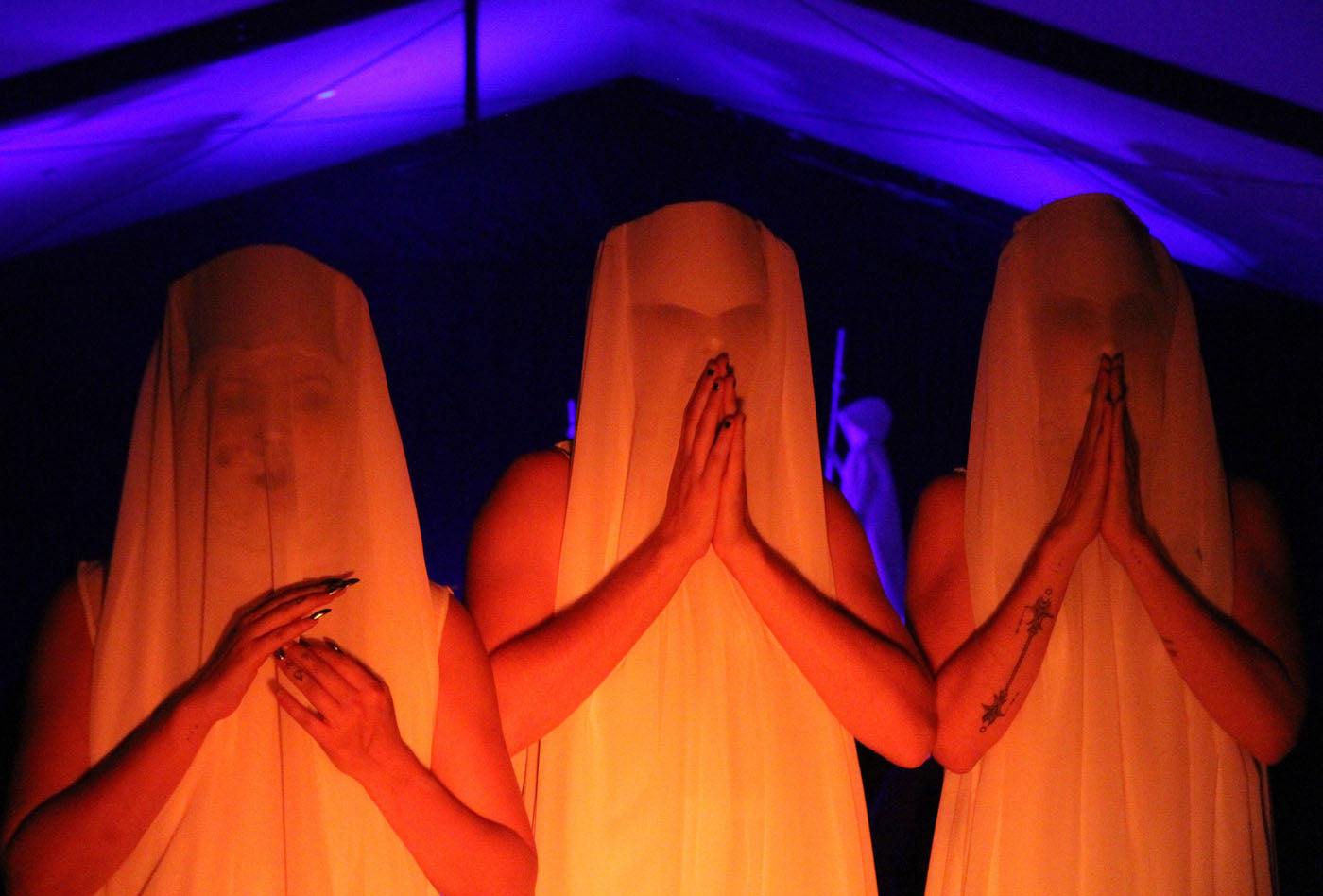Not to be outdone, there were throngs aplenty last weekend, as well, including the presence of iconic choreographer William Forsythe, all taking in the evening-length work that is loosely based on Plato’s Allegory of the Cave. Conceptualized and choreographed by WIFE, the immersive story of transformation and transcendence featured a cast of 13, with provocative sets, lighting, costumes, music and projected body-mapping animations adding to the rave-y vibe of the evening.
Unfortunately, the statuesque and otherworldly Albuquerque was injured the night this reviewer was in attendance, but a very capable Tess Hewlett filled in gamely.
Dimmed lights accented by eerie blues (designed by Ryan Granich), signaled the show’s start, as artist Dorian Wood entered, quasi-throat singing. Shrouded in Cathy Cooper’s full-length ghostly garb, face obscured, he moved through the space—also weaving amid standing onlookers—with conviction, crooning in a spectral, Twilight Zone-ish voice.
A trio of additional singers—Blake Perlman, Lisa McNeely and Danny Axley—also in white and darting about with dexterity, contributed to the mystical feel of the music, while three women, hooded, brandished sticks, Capoeira style. Indeed, Allison Fletcher, Toiya Leatherwood and Dani Scaringe, lent a Kubrickian, Eyes Wide Shut sensibility to the first act, with a giant white skirt (fabricated by Sami Martin Sarmiento and Megan Feely), looming large as if patiently waiting to come to Frankensteinian life.
Three additional dancers—Gabriella Cataldo, Kenzie McClure, Nadine Olmo—emerged from the top of the bridal white skirt, sporting faux pearl-encrusted headdresses and moving their upper bodies and arms in well-choreographed unisons. Think super-powered Siamese triplets—on acid—or whatever drugs (besides hemlock), were taken back in Plato’s time, the area then bathed in red hot tones.
With the addition of Jon Bates’ pulsating music, a decidedly aural force, the scene began to feel more like some sort of secret ceremony, the audience—or at least this viewer—mesmerized by the surreal ritual. The lights soon faded and we were ushered into another room, this one, happily, with chairs.
According to the press notes, “the past, present, and future are blended into one reeling reality,” where “confusion and chaos ensue.” A lofty notion, to be sure, and one in which the second act exploded with the presence of WIFE. Standing atop a set made to resemble rocky crags, a volcanic landscape or Stonehenge gone amok, the trio was a tour guide to a funhouse ride, standing in relief against the blackness of the unknown, one that recalled Socrates’ description of a group of people living chained to the wall of a cave.
Looking like a cross between Marie Antoinette and Grace Jones, sun-dialesque headdresses balanced atop their heads, WIFE had a uniform demeanor that was simultaneously fierce and expressionless. The trio beckoned us to join them on their riveting, mind-expanding journey, now accompanied by the ear-piercing, thrumming score of Steve Nalepa + The Acid, with Nina McNeely’s animated projections a kind of psychedelic enabler/enhancer.
The faux rocks came to life with cartoonish tableaux of confetti, martini glasses and volcanic lava, with smoke occasionally spewing behind and between the dancers. The precise, mechanized movements of WIFE (Hewlett learned her part in three hours, a feat in and of itself), were a kinetic riot. Dressed in long sleeveless gowns, accentuated by pointy, embossed breasts reminiscent of Madonna’s conical bra dress that was created by Jean Paul Gaultier (costumes by Sara Sachs + Alexandra Borner), the female brigade maintained stiff upper torsos much of the time, arms Shiva-like on occasion, and always in character.
But as what?
This is the beauty of WIFE. They are blood red and you bleed with them; they turn slowly à la Robert Wilson, and you are the ballerina atop an off kilter music box; they are caged wildebeests and you are on their oddball safari. The minimalist choreography of this triad, coupled with McNeely’s eye-popping visuals, take you to the most far-out places imaginable.
Autumn leaves, gilded, recall King Tut, before morphing into bouncing balls in luscious hues of yellow, red and blue. The musical crescendos, staccato-like with machine-gun rhythms, burned into brains, as pennies seemed to fall from heaven, or from a galaxy far, far away.
Fire, water and earth are the provinces of their crania, where gestures become poetry and arched backs and pliés are novellas. WIFE beseeches the audience to enter the darkness, their repetitious machinations unpredictable, a hint of Vegas showgirl also on view. These trance-inducing creatures live in the cool confines of their cave, before Druids with sticks happen upon them and imaginary power plays unfold.
Three bodies, one psychophysicalized being, that is WIFE, where a return to the womb is followed by an expulsion from the emptiness, the void. This was, as Socrates once wrote, “the rising of the soul into the world of the mind.” Wherever can be imagined, WIFE takes you there, grabbing you tightly, only to let you go, hurling you into the universe, a renewed, radically changed (at least temporarily), version of yourself.
Like Cathy in Wuthering Heights, who so boldly stated, “I am Heathcliff,” it would also be very cool to proclaim, “I am WIFE.”




comments